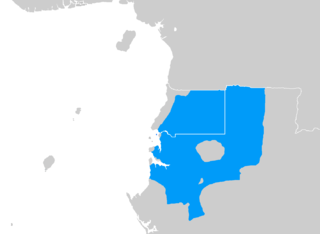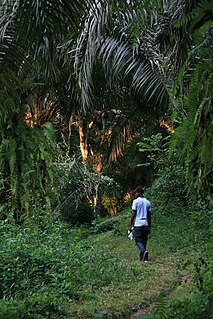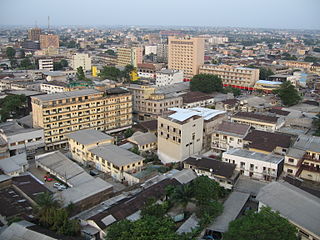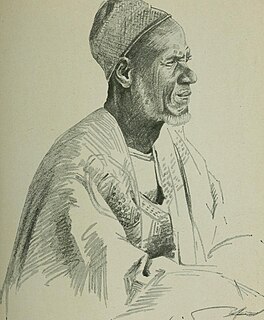
Cameroon, officially the Republic of Cameroon, is a country in Central Africa. It is bordered by Nigeria to the west and north; Chad to the northeast; the Central African Republic to the east; and Equatorial Guinea, Gabon and the Republic of the Congo to the south. Cameroon's coastline lies on the Bight of Biafra, part of the Gulf of Guinea and the Atlantic Ocean. Although Cameroon is not an ECOWAS member state, it is geographically and historically in West Africa with the Southern Cameroons which now form her Nord-Ouest and Sud-Ouest Regions having a strong West African history. However, since 2017, elements within the Sud-Ouest and Nord-Ouest regions have since declared an independent state called Ambazonia. The country is sometimes identified as West African and other times as Central African due to its strategic position at the crossroads between West and Central Africa. Cameroon is home to over 250 native languages spoken by nearly 20 million people.

Fang is a Central African language spoken by around 1 million people in Cameroon, Gabon, Equatorial Guinea, São Tomé and Príncipe, and the Congo Republic. It is the dominant Bantu language of Gabon and Equatorial Guinea. It is related to the Bulu and Ewondo languages of southern Cameroon. Fang is spoken in northern Gabon, southern Cameroon, throughout Equatorial Guinea, in the Republic of the Congo, and small fractions of the islands of São Tomé and Príncipe. Under President Macías Nguema, Fang was the official language of Equatorial Guinea.
Bikya is a potentially extinct Southern Bantoid language spoken in Cameroon. It is one of the three, or four, Furu languages. In 1986 four surviving speakers were identified, although only one spoke the language fluently.

Cameroon is a Central African nation on the Gulf of Guinea. Bantu speakers were among the first groups to settle Cameroon, followed by the Muslim Fulani until German domination in 1884. After World War I, the French took over 80% of the area, and the British 20%. After World War II, self-government was granted, and in 1972, a unitary republic was formed out of East and West Cameroon. Until 1976 there were two separate education systems, French and English, which did not merge seamlessly. English is now considered the primary language of instruction. Local languages are generally not taught as there are too many, and choosing between them would raise further issues.
The Fang-Beti are a Bantu ethnic group located in rain forest regions of Cameroon, Republic of the Congo, Equatorial Guinea, Gabon, and São Tomé and Príncipe. Though they separate themselves into several individual clans, they all share a common origin, history and culture.
Cameroonian Pidgin English, or Cameroonian Creole, is a language variety of Cameroon. It is also known as Kamtok. It is primarily spoken in the North West and South West English speaking regions. Five varieties are currently recognised:
Manenguba, also known as Ngoe or the Mbo cluster, is a Bantu language spoken in Cameroon. It is a language spoken by several related peoples.

Cameroon has a rich and diverse culture made up of a mix of about 250 indigenous populations and just as many languages and customs. The country is nicknamed "Little Africa" as geographically, Cameroon consists of coastline, mountains, grass plains, forest, rainforest and desert, all of the geographical regions in Africa in one country. This also contributes to its cultural diversity as ways of life and traditional food dishes and traditions vary from geographical region to geographical region.

The Bassa are a Bantu ethnic group in Cameroon. They number approximately 230,000 individuals. The Bassa speak the Basaa language as a mother tongue, which belongs to the Bantu branch of the Niger–Congo language family.
The Kom language, Itaŋikom, is the language spoken by the Kom people of Cameroon. Shultz 1997a and Shultz 1997b contain a comprehensive description of the language's grammar.
Cameroon English is an English dialect spoken predominantly in Cameroon, mostly learned as a second language. It shares some similarities with English varieties in neighbouring West Africa, as Cameroon lies at the west of Central Africa. It is primarily spoken in the Northwest and Southwest regions of Cameroon.

Cameroon is home to at least 250 languages. These include 55 Afro-Asiatic languages, two Nilo-Saharan languages, four Ubangian languages, and 169 Niger–Congo languages. This latter group comprises one Senegambian language (Fulfulde), 28 Adamawa languages, and 142 Benue–Congo languages . French and English are official languages, a heritage of Cameroon's colonial past as a colony of both France and the United Kingdom from 1916 to 1960. Eight out of the ten regions of Cameroon are primarily francophone, representing 83% of the country's population, and two are anglophone, representing 17%. The anglophone proportion of the country is in constant regression, having decreased from 21% in 1976 to 20% in 1987 and to 17% in 2005, and is estimated at 16% in 2015.
Kako is a Bantu language spoken mainly in Cameroon, with some speakers in the Central African Republic and the Republic of the Congo. The main population centres of Kako speakers are Batouri and Ndélélé in the East Region of Cameroon.

Douala is the largest city in Cameroon and its economic capital. It is also the capital of Cameroon's Littoral Region. Home to Central Africa's largest port and its major international airport, Douala International Airport (DLA), it is the commercial and economic capital of Cameroon and the entire CEMAC region comprising Gabon, Congo, Chad, Equatorial Guinea, Central African Republic and Cameroon. Consequently, it handles most of the country's major exports, such as oil, cocoa and coffee, timber, metals and fruits. As from 2018, the city and its surrounding area had an estimated population of 2,768,400. The city sits on the estuary of Wouri River and its climate is tropical.
The General Alphabet of Cameroon Languages is an orthographic system created in the late 1970s for all Cameroonian languages. Consonant and vowel letters are not to contain diacritics, though ⟨ẅ⟩ is a temporary exception. The alphabet is not used sufficiently for the one unique letter, a bilabial trill, to have been added to Unicode.

Postage stamps have been used in Cameroon or Cameroun since the nineteenth century.
Mbule, also called Dumbule or Mbola, is an endangered Southern Bantoid language spoken by a few people in central Cameroon.
Iyive, also referred to as Uive, Yiive, Ndir, Asumbos, is a severely endangered Bantoid language spoken in Nigeria and Cameroon. The ethnic group defined by use of this language is the Ndir.

The Mandara people, also known as Wandala or Mandwara, are a Central African Muslim ethnic group found in north Cameroon northeastern Nigeria, and southeastern Chad. They speak the Wandala language, which belongs to the Chadic branch of Afro-Asiatic languages found in northeastern Africa.

The COVID-19 pandemic in Cameroon is part of the worldwide pandemic of coronavirus disease 2019 caused by severe acute respiratory syndrome coronavirus 2. The virus was confirmed to have reached Cameroon in March 2020.








